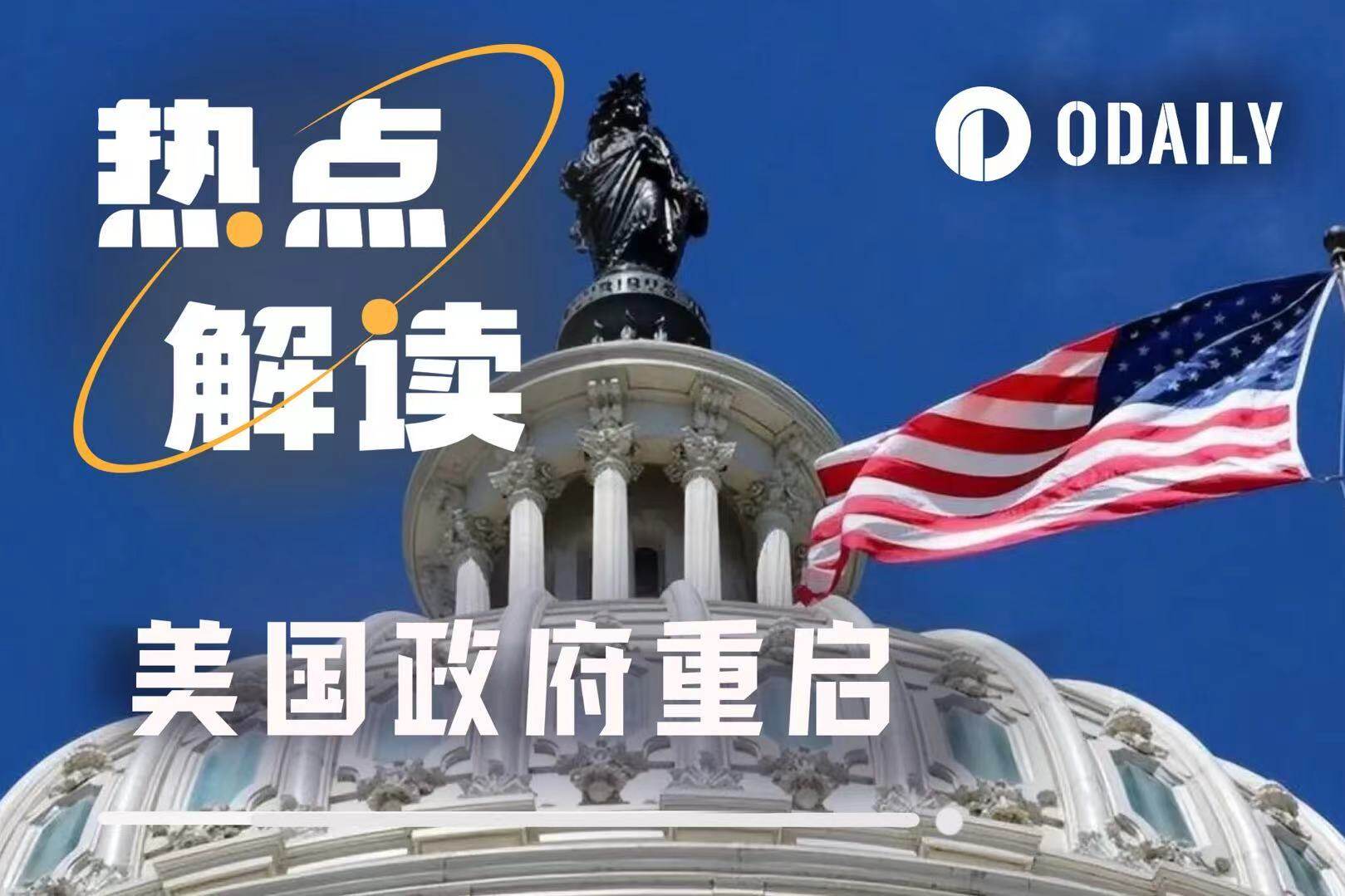Why is the market not buying into the reopening of the US government after a 43-day shutdown?
Original article | Odaily Planet Daily ( @OdailyChina )
Author|Golem ( @web3_golem )
The 43-day shutdown of the U.S. federal government finally ended today.
On November 13, the House of Representatives passed a temporary funding bill by a vote of 222 to 209, and Trump signed it into law that morning. The bill will inject funds into food aid programs that were disrupted during the shutdown, provide back pay for hundreds of thousands of federal employees, and restore normal operation of the air traffic control system. The White House also stated that the September Bureau of Labor Statistics data will be released after the government reopens, but the key economic report for October may not be released at all.
Everything is getting back on track, but the market doesn't seem to be experiencing a strong rebound despite the government's reopening – BTC briefly fell below $101,000 again early this morning, and the overall market is trending downwards. Besides the improved macroeconomic environment, the crypto market seems to need more catalysts to generate stronger upward momentum.
Why did the US government shut down for 43 days?
Historically, there have been 21 government shutdowns since 1976, but the shutdown that began on October 1, 2025, broke the previous record of 35 days.
This record-breaking shutdown stemmed from the failure of Republicans and Democrats to reach an agreement on a new budget in October. The main point of contention was healthcare spending; Democrats demanded an extension of the expiring tax credit to allow millions of Americans to continue enjoying lower Medicare costs, while Republicans insisted on cutting health and government healthcare-related spending to control the overall budget.
Although the House of Representatives passed a temporary funding bill to avert a government shutdown, a protracted standoff between Democrats in the Senate ultimately led to a formal government shutdown starting October 1st. However, despite the passage of the temporary funding bill, the two parties are still arguing over federal Medicare subsidies, and the Democrats have failed to achieve their goal of extending Medicare subsidies.
The core contradiction of this dispute remains unresolved.
The divergent performances of US stocks and the crypto market during the US government shutdown
The US government shutdown has not only disrupted the daily lives of Americans but also impacted the wallets of investors worldwide. The market believes the shutdown will have a negative impact.
Firstly, the US government shutdown prevented economic departments such as the Department of Labor from operating normally, and important economic data such as the CPI and non-farm payroll reports could not be released on time, causing the Federal Reserve to make "blind" decisions, which cast a shadow over the market.
Secondly, the US government shutdown also drained market liquidity. The US Treasury General Account (TGA) is responsible for all government spending, not only paying US civil servants' salaries but also injecting capital into the financial markets. The US government shutdown meant that the TGA could only inflow but not outflow. According to MacroMicro data, during the US government shutdown, the TGA accumulated more than $145.9 billion, and the current balance is $965.3 billion.

However, TradingView data shows that during the US government shutdown (October 1 to November 13), the three major US stock indices did not fall sharply, but instead rose. The Dow Jones Industrial Average rose 3.5%, the S&P 500 rose 3%, and the Nasdaq Composite rose 2.9%. Gold rose more than 8.5% during the US government shutdown and hit a new high of $4,355 on October 22.
The crypto market lived up to expectations, experiencing a significant drop. On October 11th, the crypto market witnessed the "1011" crash, setting a record for single-day liquidations exceeding $19.1 billion, with Bitcoin even falling below $99,000. Although the market recovered somewhat after the "1011" crash, it remained generally sluggish. During the US government shutdown (October 1st to November 13th), BTC fell by 14%, ETH by 20%, SOL by 30%, and BNB by 6.67%.
It is evident that the US government shutdown did not have as significant a negative impact on global markets as some had anticipated. The decline in the cryptocurrency market during this period was the result of multiple factors, such as continued outflows from spot Bitcoin ETFs, the decline of DAT, weakened expectations of a Federal Reserve interest rate cut, and internal crises within the cryptocurrency industry.
The market may have overestimated the impact of the US government's reopening.
Since the US government shutdown is only a minor factor affecting global market volatility, investors may have overestimated the impact of the US government's reopening on the market.
U.S. stocks closed on Wednesday with only the Dow Jones Industrial Average rising 0.78%, the S&P 500 slightly higher, and the Nasdaq Composite falling 0.26%, amid high expectations of a Senate vote to pass the bill and the reopening of the U.S. government. The cryptocurrency market has yet to recover from its slump, with BTC still down 1.04% on the daily chart. The reopening of the U.S. government is hardly a positive factor for the cryptocurrency market.
Historically, blogger @BunnyTalks_ has summarized a pattern: during the major US government shutdowns of 1995-1996, 2013, and 2018-2019, although the US stock market remained stagnant during the shutdowns, it tended to rise after the shutdowns ended. Whether this pattern will hold true again remains to be seen, depending on the performance of the US stock market at its opening tonight.
There is no inherent pattern in the crypto market where prices will inevitably rise after a government shutdown. Statistics show that since Bitcoin was officially given a market price, the US government has shut down three times.
- October 1-17, 2013: Due to the Obamacare controversy, the US government shut down for 16 days. Within a month of the US government's reopening, the price of Bitcoin did not change significantly.
- January 20-22, 2018: Due to controversy over Trump's immigration policies, the US government shut down for two days. Within a month of the US government reopening, the price of Bitcoin fell below $10,000.
- December 22, 2018 - January 25, 2019: Due to the controversy surrounding Trump's proposed wall on the US-Mexico border, the US government shut down for 35 days. Within a month of the US government's reopening, the price of Bitcoin did not change significantly.
In conclusion, past government shutdowns and reopenings have had little impact on Bitcoin and the crypto market, and we should not have high expectations for its ability to boost the market. The sharp drop in Bitcoin at the beginning of 2018 was mainly due to the deep bear market that followed the "94" crackdown.
Moreover, the impact of the "1011" crash on the crypto industry is slowly emerging. Liquidity is nearing depletion, DeFi is collapsing, and structural buying support such as ETFs and DAT is withdrawing. These factors are suppressing the upward momentum that the US government's reopening of the crypto market has brought to Bitcoin.
However, some argue that the current crypto market is different from what it used to be, especially since Bitcoin has become an "appendage" of the US stock market. Therefore, positive macroeconomic factors will play a crucial role in turning the tide. As the US government resumes normal operations and the TGA begins injecting funds into the market, previously suppressed fiscal spending of hundreds of billions of dollars will also flow into the market, at which point the crypto market will shift.
- 核心观点:美国政府重启对加密市场提振有限。
- 关键要素:
- 停摆期间BTC跌14%,美股却上涨。
- 历史三次停摆后比特币均未大涨。
- 加密市场受ETF流出等内部因素压制。
- 市场影响:加密市场仍需内部驱动因素。
- 时效性标注:短期影响



